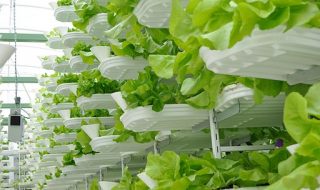Recently, I’ve become quite a fan of vertical farms. The principle is simple: instead of growing things in fields, you cultivate plant life within a skyscraper greenhouse or on vertically inclined surfaces. There are several advantages to this: they’re more productive for the space they use (about 100 times more productive), take 40% less power, 80% less food waste and 99% less water usage than outdoor fields. Now, Japanese, vertical farmer, Spread Co., has begun construction on the largest vertical farm in the world. The process will be entirely automated from seeding to harvesting and will produce 30,000 heads of lettuce per day.

The new Kyoto facility is expected to cost approximately 2 billion yen, or about $22 million, and open in 2017 – but it’s a lofty investment. Spread says it is able to recycle 98 per cent of the water used for cultivation, while cutting labour costs by 50 per cent through automation, using cheap LEDs for artificial lighting.
“There are water and food shortages due to extreme weather events accompanied by the increasing global population. Amid these problems, Spread has effectively managed energy through the vegetable factory business and has been working to lay the foundation for a more secure and sustainable society,” the company said.
Also, another advantage of this technology is that you can grow crops right in cities – therefore ensuring not only that people in the city can get fresh crops, but reducing transportation and therefore emissions. It’s also very suitable for areas with limited space for crops. It’s worth noting that the world produces way more food than we need, but much of it is wasted or produced in wrong places. Producing food in the right places is a key place to eat healthier, reduce environmental impact, and fight world hunger. The company hopes the new factory kick-starts further expansion, and personally, I hope more companies will follow their lead.



